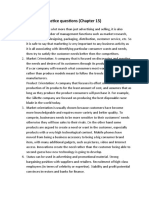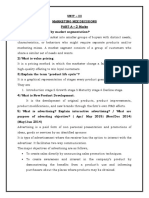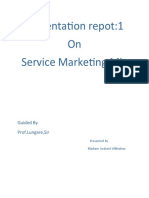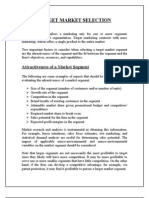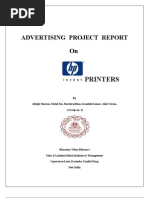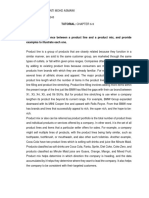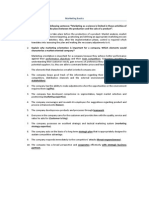MF Assgn B-Nipun
MF Assgn B-Nipun
Uploaded by
Sharmeela SabooCopyright:
Available Formats
MF Assgn B-Nipun
MF Assgn B-Nipun
Uploaded by
Sharmeela SabooCopyright
Available Formats
Share this document
Did you find this document useful?
Is this content inappropriate?
Copyright:
Available Formats
MF Assgn B-Nipun
MF Assgn B-Nipun
Uploaded by
Sharmeela SabooCopyright:
Available Formats
ACL_I-MF_ASSGNMENT-B_
1. Identification and explanation of which product range would be recommended for retail sales with reasons Scope for growth for organized retailing India is positioned as the leading destination for retail investment. Clothing and footwear retailing sector has a high growth potential in India. Clothing, footwear, sportswear and accessories retailers in India increased at a compounded annual growth rate (CAGR) of 24.1% between 2004 and 2009 As sportswear retailing in India remains focused on mens clothing, there exists a plethora of opportunities in the exclusive ladies' and kids sportswear segment. This segment still remains the most untapped segment as 80 to 90 percent purchases happen in unorganised markets. The domestic market is substantially price driven, with branded sportswear constituting less than 42 percent of the total market size. The Indian sportswear market scores over other markets as it gives benefits like low cost of production, abundant raw material, and has huge consumption market. Many international and domestic companies are entering into the Indian sportswear market either individually or through joint ventures like Reebok, Benetton, Tata International, Reliance, RPG etc. large youth population, favorable civic situation, favorable demography, Easy availability of credit, Rising Income and consumption patterns, increased acceptance of mall culture. E x a m p l e s : Pantaloon Retail (India) Limited is Indias leading retailer that operates multiple retail formats in both the value and lifestyle segment of the Indian consumer market includes Pantaloons (a chain of fashion outlets ), Depot, Shoe Factory, Brand Factory, Blue Sky, Fashion Station, aLL etc. It offers around 120 leading global brands such as Reebok, Adidas, Esprit, Van Heusen, Levis etc. 70% of their business is done by selling their own products. The company can follow the example of Pantaloons Retail India and maintain the survival factor of selling branded products and also launch its home products under its own brand name and increase its customer base in India over a period of time.
Conclusion With global companies gaining entry in the Indian sportswear retail market, the company should opt for sports goods retailing focusing especially on exclusive range of style, design and comfort. With existing manufacturing capabilities and existing brand, our company has immense potential for growth for retail sales in the Indian market.
Indias economic development, supportive government policies, globalization,
2. Recommendation for pricing and promotion with reasons for doing so. Introduction: Companies selling or manufacturing athletic sporting goods in todays marketplace face a variety of challenges. Time-to-market continues to decrease while consumer expectations for quality and safety increase, and economic conditions change. In this dynamic environment, winning products need winning solutions that go beyond simple testing to help companies effectively balance cost and risk to protect their brand. Pricing strategies: 1. Penetration pricing: This pricing is done to help a product penetrate into the market to hold a position and is intended to capture the market, by adopting a low price in the initial period or till it is finally accepted by the customers. Low starting prices sacrifice short term profits for long term profits. It is adopted when substitute product is marketed. 2. Competitive pricing: Use competitors prices as a benchmark for setting the prices. Price slightly below, above or the same as the competitors, depending on the Co.s positioning strategies. 3. Skimming Pricing: Under this policy a high price is initially fixed to skim the cream of the market and the price moves step by step until the right price is reached. It is launched while introducing a new product into the market. 4. Prestige pricing: This price is one that is fixed at a price higher than the producers near perfect substitute. 5. Bundling and quality discounts: Rewarding customers for larger purchases by giving quantity discounts or bundling. For example, set the per unit price lower when the customer purchases more quantity. Bundling is done when the customer purchases a bundle or does bulk purchases of several related items at one time. Bundling overstocks with popular items and bundling established items with a new product to build consumer awareness can also be done. Promotional strategies: 1. Use magazines, newspapers, television, radio, hoardings, internet etc for advertising the brand. E.g. appointing famous Sports personalities as brand ambassadors, sponsoring Cricket clubs and general sporting activities in India. 2. Introduce PR (public relations) to develop positive image of the Company. 3. Enter into joint ventures and alliances with many companies to promote the brand. 4. Different types of sales promotions like Seasonal Discounts, Sales Discounts during festivals can be offered to attract consumers especially women and kids, distribution of sportswear kit to Cricket clubs and retailers all over the country. 5.
6. The Company can also offer a minimum discount of 20% for its merchandise and target customers in the 20-35 age groups. By doing so, many leading companies have more than a million customers within their first year of operation. 7 . Personal selling, Direct Mail, sales campaign from time to time are medium of personalized advertising which increases the response rates and thereby results in improving sales and image of the Companys products. 8 . Operating through an online portal is a parallel and effective medium of sales promotion e.g. Pantaloon Retail India, also operates an online portal, futurebazaar.com. Initially, the company should play with customers psychology by displaying its home products under its own brand name along with its products under leading brands name in all its multi-brand retail outlets. The customers should get a feeling that they are buying products of a local brand which is superior in quality and reasonable in cost, when they compare Sports label with leading brands. Pricing and promotional tactics should be framed in such a manner so that the PLW products under Sports Label Brand look far better and superior to the leading brands with respect to quality and cost. Additional efforts must be made to blend the look, touch and feel of Indian bazaars with aspects of modern retail like choice, convenience and quality. This in turn will lead to increase in customer base in India.
Later on, when the company establishes monopoly in the Indian market, it can sell its home products under its own brand name cutting down operational and intermediary costs (manufacturers, suppliers, wholesalers and retailers share in Co.s profits) to a large extent and thereby increase its profit margin and recover investment costs. It can also extend its product range in the years to come. It is important to determine
Who the consumer is-Demographic base of age, economic status, residence etc. What the consumer buys-Products, Brands, Colours and Flavours etc.
3. Identification of relevant STP to be adapted to support the brand in view of the big players in the market. Introduction Target marketing requires marketers to take 3 important steps like Market segmentation, targeting and positioning which enable an organization to gain competitive advantage in the market 1. Market Segmentation: This task involves dividing the entire market into distinct groups with distinct needs containing identifiable consumers who seek similar benefits from a product.
It is important to determine Who the consumer is-Demographic base of age, economic status, residence etc. What the consumer buys-Products, Brands, Colours and Flavours etc. What kind of shopping trip is typical-In/Out, Convenience, Destination trip etc. How the consumer buys-By Promotion, Price or Product or Place How often the consumer buys-Daily, Weekly or Monthly. Based on the companys requirement, the following market segmentation can be done: GEOGRAPHIC-urban, metropolitan cities DEMOGRAPHIC- Family Size-family life cycle, Income-upper middle &high income group PSYCHOGRAPHIC- Socioeconomic Class-A1, A2, B2 , Lifestyle-culture-oriented, sportsoriented, outdoor- Oriented BEHAVIORAL- Occasions-regular, Benefits-quality, economy, service User status-regular, Usage rate-medium, Loyalty status-medium & strong, Attitudepositive 2 . Target Market Selection and Product differentiation: In this, the marketers must carry out the task of deciding the marketing mix to be adopted for their product so that it stands out from the competitors product. Once the retailer has identified a feasible market segment opportunities, it has to decide on a targeting approach which revolves around How many segments to target? Which segments to target? Single Segment Concentration/ Market Specialization/Product Specialization? As per the profile of the company, we need to adopt the people oriented approach and divide the different market segments into a. Higher and upper middle class customers including sports personalities. b. The large and growing young working population is a preferred customer segment. c . Specifically target working women and home makers who are the primary decision makers. d . Kids segment, as the women would be accompanied by small children most of the time for shopping. 3 Positioning: The marketers have to formulate a positioning statement for Its brand and its products. This would help in creating a unique association of the product in the consumers mind. How the Co. wants to be perceived by its target audience should be considered. Pricing the Co.s premium product too low will make the customers disbelieve the quality of the product. On the other hand, putting a high price tag on the products considering their high quality makes the customers purchase competitors lower price-items.
Steps in Segmentation, Targeting and Positioning (STP)
A. Mass Marketing: Mass productions, mass distribution and mass promotion of one product to all buyers. Mass marketing creates the largest potential market, which leads to the lowest costs, which in turn can lead to lower prices and higher margins. Explosion of the advertising media and distribution channels has made it difficult and increasingly expensive to reach a mass audience. B. Micro Marketing: Many companies are turning to micromarketing these days by choosing one of the four levels: a. Segment Marketing b. Individual marketing c. Niche Marketing d. Local Marketing In my opinion, the company being successful in establishing its premium brand identity and having product range of its own in the highly competitive global markets can also be successful in establishing its own brand identity in india provided it is fully aware of the domestic market scenario.
You might also like
- Marketing AssimentDocument8 pagesMarketing AssimentAvesh BarodawalaNo ratings yet
- Introduction To Big BazaarDocument24 pagesIntroduction To Big BazaarRockyLagishettyNo ratings yet
- Unit 1Document36 pagesUnit 1Sonny JoseNo ratings yet
- AS Level Exam Practice Questions-Chapter 16Document3 pagesAS Level Exam Practice Questions-Chapter 16Velile KonaNo ratings yet
- Consumer Buying Behaviour and New Product Development Assignment MMS-B Roll No. 105Document8 pagesConsumer Buying Behaviour and New Product Development Assignment MMS-B Roll No. 105DEEPAK NIRULKARNo ratings yet
- Home TextilesDocument8 pagesHome TextilesJammu NavaniNo ratings yet
- Synopsis A Research Project On - Marketing Analysis of Shopper's StopDocument11 pagesSynopsis A Research Project On - Marketing Analysis of Shopper's StopChanpreet Singh GroverNo ratings yet
- Project On Sales Promotion in Big BazaarDocument106 pagesProject On Sales Promotion in Big BazaarNaina SoniNo ratings yet
- Bachelor in Business Administration Semester 3: Prepared For: Lecturer's NameDocument9 pagesBachelor in Business Administration Semester 3: Prepared For: Lecturer's NameBrute1989No ratings yet
- Why Points of Parity Is ImportantDocument4 pagesWhy Points of Parity Is ImportantNafisaRafaNo ratings yet
- BIG Bazaar: A Report On Merchandising PhilosophyDocument21 pagesBIG Bazaar: A Report On Merchandising Philosophychakri5555No ratings yet
- Marketing Management QUESTION PAPERDocument5 pagesMarketing Management QUESTION PAPERKuthubudeen T M50% (2)
- IB - Marketing Unit 4.1Document22 pagesIB - Marketing Unit 4.1Emmanuel GeorgeNo ratings yet
- EEM - Module 9 Marketing ManagementDocument21 pagesEEM - Module 9 Marketing ManagementArjunAgharaNo ratings yet
- Synopsis Retail Marketing in India: The Moblie Store Ltd. Powered byDocument6 pagesSynopsis Retail Marketing in India: The Moblie Store Ltd. Powered byVinit SharmaNo ratings yet
- Prangue Lexter Assignment1 BAPRDocument7 pagesPrangue Lexter Assignment1 BAPRLexter PrangueNo ratings yet
- Unit 3 MM Students NotesDocument18 pagesUnit 3 MM Students NotesN.NevethanNo ratings yet
- SanjeetDocument73 pagesSanjeetSalman RazaNo ratings yet
- Chapter 16 - What Is MarketingDocument46 pagesChapter 16 - What Is MarketingradhikaiyerNo ratings yet
- CB & Ms AssignmentDocument9 pagesCB & Ms AssignmentAyesha QureshiNo ratings yet
- PB 1Document2 pagesPB 1Rohit ParadoxNo ratings yet
- BMN 511 Marketing Management 2: Assignment 3Document2 pagesBMN 511 Marketing Management 2: Assignment 3Aditya GuptaNo ratings yet
- Entrep Module 6Document28 pagesEntrep Module 6VICTOR, KATHLEEN CLARISS B.No ratings yet
- Marketing ManagementDocument10 pagesMarketing ManagementAkshat JainNo ratings yet
- Retailing in India Retailing in IndiaDocument8 pagesRetailing in India Retailing in Indiarachita_mehtaNo ratings yet
- Tservice Marketing Mix/Extended Marketing MixDocument14 pagesTservice Marketing Mix/Extended Marketing MixSsushant MadaneNo ratings yet
- Select A Company and Prepare Consumer Promotion. Study and Analyse Competitor's Consumer PromotionDocument13 pagesSelect A Company and Prepare Consumer Promotion. Study and Analyse Competitor's Consumer PromotionpujaNo ratings yet
- The Below Figure Depicts The STP Process For A Skincare ProductDocument35 pagesThe Below Figure Depicts The STP Process For A Skincare Productshubham kumarNo ratings yet
- FMCG ProjectDocument53 pagesFMCG ProjectAshish YadavNo ratings yet
- Today's: This Chapter Examines The Role CompetitionDocument8 pagesToday's: This Chapter Examines The Role CompetitionCindy VillaromanNo ratings yet
- Block 4 Assessment OneDocument8 pagesBlock 4 Assessment OneGift SimauNo ratings yet
- Marketing: 5, 6, 7, 8, 9 and 10Document16 pagesMarketing: 5, 6, 7, 8, 9 and 10Ana García BarbelNo ratings yet
- 4.2 Key Issues and Current TrendsDocument9 pages4.2 Key Issues and Current TrendsPiyush SondarvaNo ratings yet
- Unit 1Document7 pagesUnit 1Emily CiliaNo ratings yet
- Target Market SelectionDocument10 pagesTarget Market SelectionShaheen OmarzadahNo ratings yet
- Digital Assignment 01Document7 pagesDigital Assignment 01Prithivi RajNo ratings yet
- MarketingDocument64 pagesMarketingAbhilekhNo ratings yet
- Advertising Project Report On: PrintersDocument30 pagesAdvertising Project Report On: Printersabhijitsharma1988No ratings yet
- DocumentDocument4 pagesDocumentSimrat RangiNo ratings yet
- Session 8Document5 pagesSession 8kalu kioNo ratings yet
- Marketing TermpaperDocument8 pagesMarketing TermpaperMohammad RashidNo ratings yet
- My SMM-2Document8 pagesMy SMM-2Nhi Pham TuyetNo ratings yet
- Chap1 7Document17 pagesChap1 7Hùng LeoNo ratings yet
- FMCG Industry Analysis - ReportDocument6 pagesFMCG Industry Analysis - ReportPrateek SabharwalNo ratings yet
- Marketing : Product Life CycleDocument27 pagesMarketing : Product Life CycledattacuriousNo ratings yet
- Principle of Marketing (Chapter 6 - 9)Document4 pagesPrinciple of Marketing (Chapter 6 - 9)Nur ShabrinaNo ratings yet
- Marketing, Competition and The CustomerDocument4 pagesMarketing, Competition and The CustomerHellen KahuraNo ratings yet
- HariDocument14 pagesHariurstrulypeaceNo ratings yet
- Biscuit IndustryDocument24 pagesBiscuit IndustryAmit SinghNo ratings yet
- A Company That Take Place Between The Production and The Sale of A Product"Document3 pagesA Company That Take Place Between The Production and The Sale of A Product"p_vasilikosNo ratings yet
- Marketing Mix (Price, Place, Promotion, Product) : What Is Product PositioningDocument6 pagesMarketing Mix (Price, Place, Promotion, Product) : What Is Product PositioningFiroz AzeezNo ratings yet
- Brand: Bata India Limited Category: Casual Foootwear Designing The Promotional CampaignDocument30 pagesBrand: Bata India Limited Category: Casual Foootwear Designing The Promotional CampaignParth PatelNo ratings yet
- Brand MNGMTDocument9 pagesBrand MNGMTRohan HiremathNo ratings yet
- Segmentation Targeting PostioningDocument80 pagesSegmentation Targeting PostioningNayana RajeshNo ratings yet
- Review and Discussion Questions: External OpportunitiesDocument4 pagesReview and Discussion Questions: External OpportunitiesMuthiah Farah100% (1)
- Mrke Ting ProjectDocument13 pagesMrke Ting ProjectPrateek ThakurNo ratings yet
- Explaining The Process of STP & 3P's of Marketing Perspective To Jockey IndustryDocument3 pagesExplaining The Process of STP & 3P's of Marketing Perspective To Jockey IndustrySoumadeep GuharayNo ratings yet
- Growing Your Retail Business: Growing Your Retail Business, #1.5From EverandGrowing Your Retail Business: Growing Your Retail Business, #1.5No ratings yet



